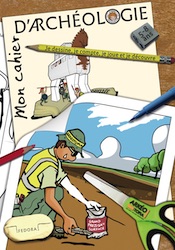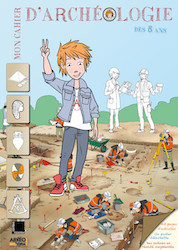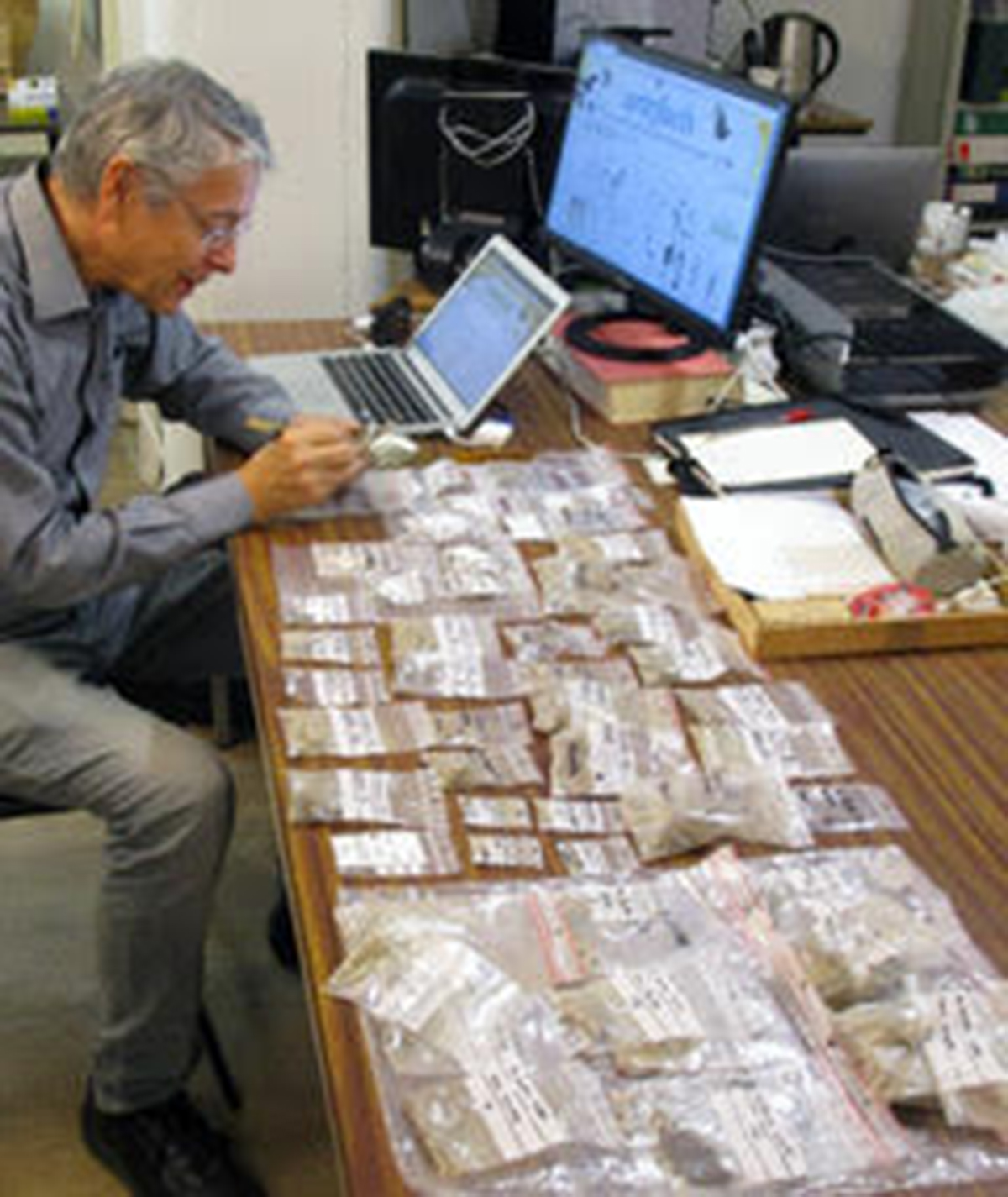Join Augustin, Alex, Lisa and the whole ArkeoTopia team to discover additional resources for step 6.3 of My Archaeology Book about analyzing archaeological remains in the laboratory using stylistic dating.
Step 6.3 – In the Lab
Archaeological Dating Techniques
Corresponding pages in MAB1 and MAB2
MAB 1 p. 28 and MAB 2 p. 34
More about this step’s reference artifact


The drawing on pages 28 and 34 of My Archaeology Book titled Archaeological Dating Techniques was inspired by a Celtic sword from the Iron Age. This sword helps to illustrate the important process of dating artifacts, for example using typology, to determine their age and cultural context.
This Celtic sword, purchased on the art market in 1999 from the Rogers collection, is characteristic of the Iron Age and is said to have been found in Switzerland but other details of its history are unknown. Its dimensions are 19 5/8 x 2 5/8 x 7/8 in. Although the blade is iron, the hilt and scabbard were crafted from a copper alloy.
It is currently exhibited at the Metropolitan Museum of Art (New York, USA) under the inventory number 1999.94a-d in Gallery 301 (North Gallery), which focuses on the end of the Roman Empire and the beginning of the Byzantine era.
The sword boasts an X-shaped hilt representing a human form that hints at a Celtic warrior. It was dated to around 60 BCE using stylistic dating. Typology is is a necessary prerequisite that makes stylistic dating possible. The word typology comes from the root type, which refers to all of the general forms that characterize a group of beings or things, and the suffix -logy, which means “to speak about, to know.”

 Typology thus enables archaeologists to talk about characteristics. In this case, it could help differentiate between a Celtic sword and a Greek sword. These differences make it possible to categorize archaeological remains by type to date them more accurately and/or determine their function and cultural context. It is also what the Russian archaeologist Vladislav Ivanovich Mamontov is doing in the photo: dating pottery fragments using comparison catalogs for ceramics.
Typology thus enables archaeologists to talk about characteristics. In this case, it could help differentiate between a Celtic sword and a Greek sword. These differences make it possible to categorize archaeological remains by type to date them more accurately and/or determine their function and cultural context. It is also what the Russian archaeologist Vladislav Ivanovich Mamontov is doing in the photo: dating pottery fragments using comparison catalogs for ceramics.
Comparison catalogs enable archaeologists to link new discoveries to previous discoveries that have already been dated. Archaeologists then use this information to date the new discovery and determine its corresponding culture.
In the drawing, Lisa the archaeologist, in lab clothes, is joined by her friend Musculus, the mouse with a powerful brain. She compares the sword she just discovered on a dig, which has been placed on the table and recorded in the inventory, to the various other archaeological remains in the same category, “sword”. Thanks to the comparison catalog of swords that shows how they have changed over time, Lisa will be able to date this sword with an X-shaped hilt representing a human form that hints at a Celtic warrior to Irong Age. Using this comparison, Lisa will learn that the sword belonged to the Celtic culture of the Iron Age. Once the sword has been dated Lisa can then conclude that the other artifacts also date to the same period or are more recent.
Today’s archaeologists are increasingly opting for digital tools such as databases rather than paper catalogs. One such typology-based database is Artefacts, Online Encyclopedia of Archaeological Small Finds..
Clues
The 7 clues in MAB1 include:
- The catalog of swords over time
- The inventory record visible on Lisa’s clipboard, showing the recently-discovered sword various archaeological remains from different sites
- les différents vestiges provenant de différents sites
- The Celtic sword, which is Lisa’s reference artifact, located on the table with the other archaeological finds
- Lisa’s white lab coat, showing she’s in the lab
- The table holding the archaeological remains, showing that the work is taking place indoors
- Musculus, the mouse who works out her brain muscles, representing human intelligence working to understand human History
The 8 clues in MAB2 include:
- The catalog of swords over time
- The inventory record visible on Lisa’s clipboard, showing the recently-discovered sword
- Various archaeological remains from different sites
- The Celtic sword, which is Lisa’s reference artifact, located on the table with the other archaeological finds
- Lisa’s white lab coat, showing she’s in the lab
- The table holding the archaeological remains, showing that the work is taking place indoors
- Musculus, the mouse who works out her brain muscles, representing human intelligence working to understand human History
- Gnasher, the clever rat, also representing human intelligence working to understand human History, just like Musculus
Technical DrawingMy Archaeology Book
Resources HomepageStep 6.4 – In the Lab
Conducting Experiments
 |
 |
|
My Archaeology Book 1 |
My Archaeology Book 2 |

 My Archaeology Book, or MAB, is an activity workbook that combines creativity, fun and learning. Alongside young Augustin, a curious and courageous boy, children meet Alex and Lisa, two friendly archaeologists who will lead them to discover archaeology and French heritage. Each drawing illustrates a situation that Alex and Lisa might encounter at work. Depending on the age of the child and the workbook, children follow easy-to-understand symbols in order to experiment with activities such as coloring, drawing, observation games, riddles and reading in order to see the world through an archaeologist’s eyes. Alone, with family, at school or just for fun, children expand their knowledge and gain skills, all while having fun.
My Archaeology Book, or MAB, is an activity workbook that combines creativity, fun and learning. Alongside young Augustin, a curious and courageous boy, children meet Alex and Lisa, two friendly archaeologists who will lead them to discover archaeology and French heritage. Each drawing illustrates a situation that Alex and Lisa might encounter at work. Depending on the age of the child and the workbook, children follow easy-to-understand symbols in order to experiment with activities such as coloring, drawing, observation games, riddles and reading in order to see the world through an archaeologist’s eyes. Alone, with family, at school or just for fun, children expand their knowledge and gain skills, all while having fun.
On this section, you will find additional resources: color photos of archaeological documents that inspired My Archaeology Book, additional teaching documents (flip-book, websites, suggestions for classroom use, edutainement, etc.) and information on upcoming publications. Each page will be updated over time.






